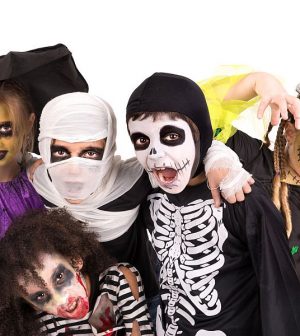- Navigating Your Midlife Crisis: Embracing New Possibilities
- City Raccoons Showing Signs of Domestication
- Mapping the Exposome: Science Broadens Focus to Environmental Disease Triggers
- One Week Less on Social Media Linked to Better Mental Health
- Your Brain Changes in Stages as You Age, Study Finds
- Some Suicide Victims Show No Typical Warning Signs, Study Finds
- ByHeart Formula Faces Lawsuits After Babies Sickened With Botulism
- Switch to Vegan Diet Could Cut Your Greenhouse Gas Emissions in Half
- Regular Bedtime Does Wonders for Blood Pressure
- Dining Alone Could Mean Worse Nutrition for Seniors
Keep Halloween Spooky, But Safe

Kids may encounter some scary surprises on Halloween, but they shouldn’t get injured while they go trick-or-treating.
However, U.S. emergency departments reported more than 700,000 Halloween-related injuries involving children and teens between 2007 and 2016. In many cases, kids are sustaining head or hand injuries, according to the National Electronic Injury Surveillance System.
“It’s essential that parents talk to kids about the importance of safety while trick-or-treating in their neighborhoods,” said Dr. Louise Reid Boyce Nichols, a pediatric orthopaedic surgeon in Wilmington, Del.
“A common danger is traffic. Both children and adults should always be aware of their surroundings, avoid distracted walking and watch out for traffic,” Nichols noted in a news release from the American Academy of Orthopaedic Surgeons (AAOS).
There are several ways children, teens and parents can avoid injuries on Halloween. Experts from the AAOS and the Pediatric Orthopaedic Society of North America recommend the following:
- Stick to sidewalks. Avoid cutting across people’s yards or driveways. It’s also important to always obey traffic signals and use crosswalks when crossing the street.
- Be visible. Adding reflective tape to costumes and goodie bags can help make sure cars and other pedestrians can see you. Dressing children in brightly colored costumes also makes them more visible once the sun goes down.
- Consider costume safety. Children and teens should not wear masks, face paint, hats or other accessories that block their vision. Costumes should also be flame-resistant. Make sure children wear costumes that fit. Wearing clothing that is too long or big increases the likelihood that children will trip and fall.
- Pick the right shoes. Trick-or-treaters should wear comfortable, sturdy shoes they can walk in without slipping or falling.
- Skip dark houses. Remind trick-or-treaters to only approach houses that are well-lit.
- Bring a flashlight. Children and parents should carry flashlights to ensure they can see and be seen on Halloween. Flashlights should not be pointed above chest height. This can block the vision of drivers or pedestrians.
- Be mindful of pets. Dogs and other pets may be anxious if strangers approach their house.
- Don’t forget a phone. Children or a supervising adult should carry a cellphone while trick-or-treating, in case of an emergency.
- Don’t let kids go out alone. Children should always be supervised by a responsible adult.
More information
The American Academy of Pediatrics offers more Halloween safety tips.
Source: HealthDay
Copyright © 2025 HealthDay. All rights reserved.










